How other universities are using staff profiles
As part of the staff profiles project, our team did some desk research into how other Russell Group universities were using staff profiles.
What we looked at
Our team is working to improve the provision of staff profiles on the University website following the migration from EdWeb to EdWeb2. To help give us an idea of, we looked at how other universities used staff profiles to give us an idea what staff used them for.
You can read more about the Role of Profiles project:
The role of profiles project brief
We looked at a range of both academic and professional services profiles across other Russell Group universities. We created a Miro board to compile screenshots and took notes on what content appeared on the profiles. We looked at:
- profiles of academic staff
- profiles of professional services staff
- what content was included on these profiles
- visual design elements of profiles.
Following the completion of this research, I wanted to highlight our key findings from our work.
There was no dominant layout for content across Russell Group universities
Across Russell Group universities, there were 3 main ways of presenting headings:
- in accordions
- in tabs
- on a long page.
Of these 3 different methods, there was no clear leading way of presenting headings on a profile.
However, using accordions was the least popular way of doing so with only small number using accordions for headings. Most either used tabs or long pages or a combination of the two.
While there was a pattern of popular headings across university staff profiles, academics use them differently
Across universities, there was a trend in headings that were most popular. While there was a theme with common headings, they were used quite differently by academics with content varying from profile to profile. The most common headings across profiles were:
- Biography/background
- Research
- PhD supervision
- Publications.
While headings were similar, how academics used them tended to vary.
The biography heading varied in name and length
Often the first heading on a profile, the biography and background section often varied in length from person to person. It also had a few variations in name and could often be titled ‘Background’ or ‘About me’ that introduced the profile holder. Some included multiple paragraphs outlining:
- their ongoing research
- projects they’re involved in
- positions they have held
- lists of their qualifications.
Others kept it short, writing a few short sentences about their study and referencing their work under different headings.
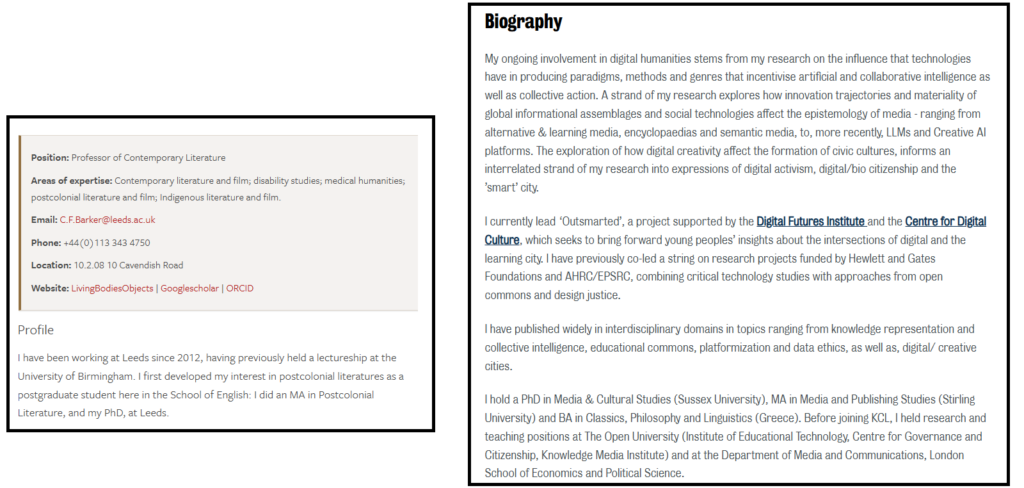
A side-by-side comparison of a short and long biography on a profile.
Academics highlighted their research in different ways
Academics used the research section differently to convey their research interests.
Research interests were sometimes listed and linked out to publications by the academic. Others wrote paragraphs about their research, also which contained links and highlighted where they received funding for their research.
How academics conveyed their research interests also varied. Some wrote multiple paragraphs which linked out to all their different work.
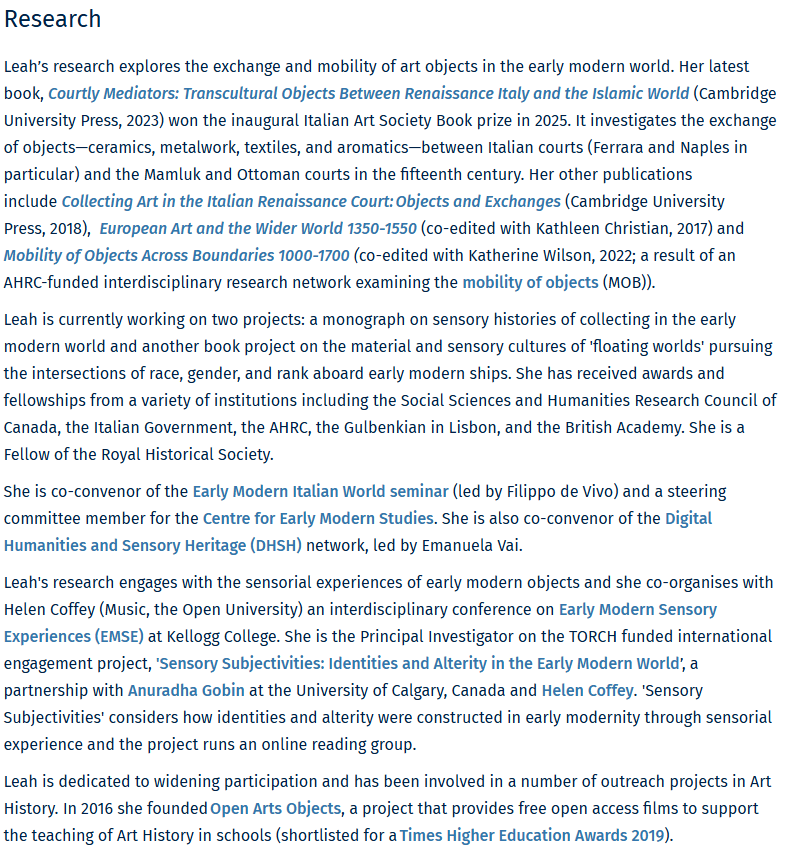
A profile from University of Oxford linking out to various publications and groups.
Others tried to keep this heading shorter and used bullet points to break up their research interests.
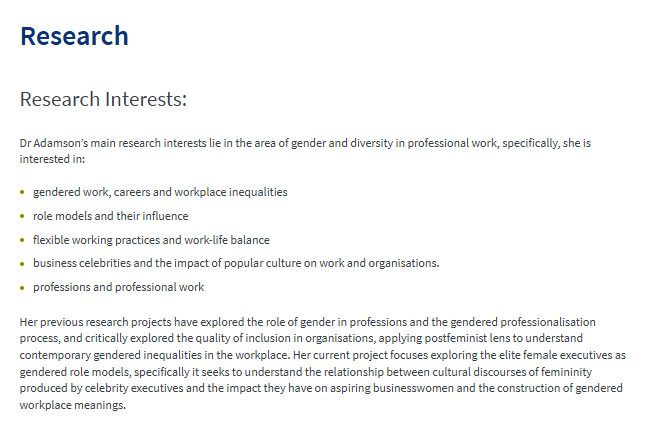
A research section which has been broken down with a subheading and is bullet-pointed.
Some also embedded videos at this part of their profile and used a video of themselves explaining their research accompanied by some text.
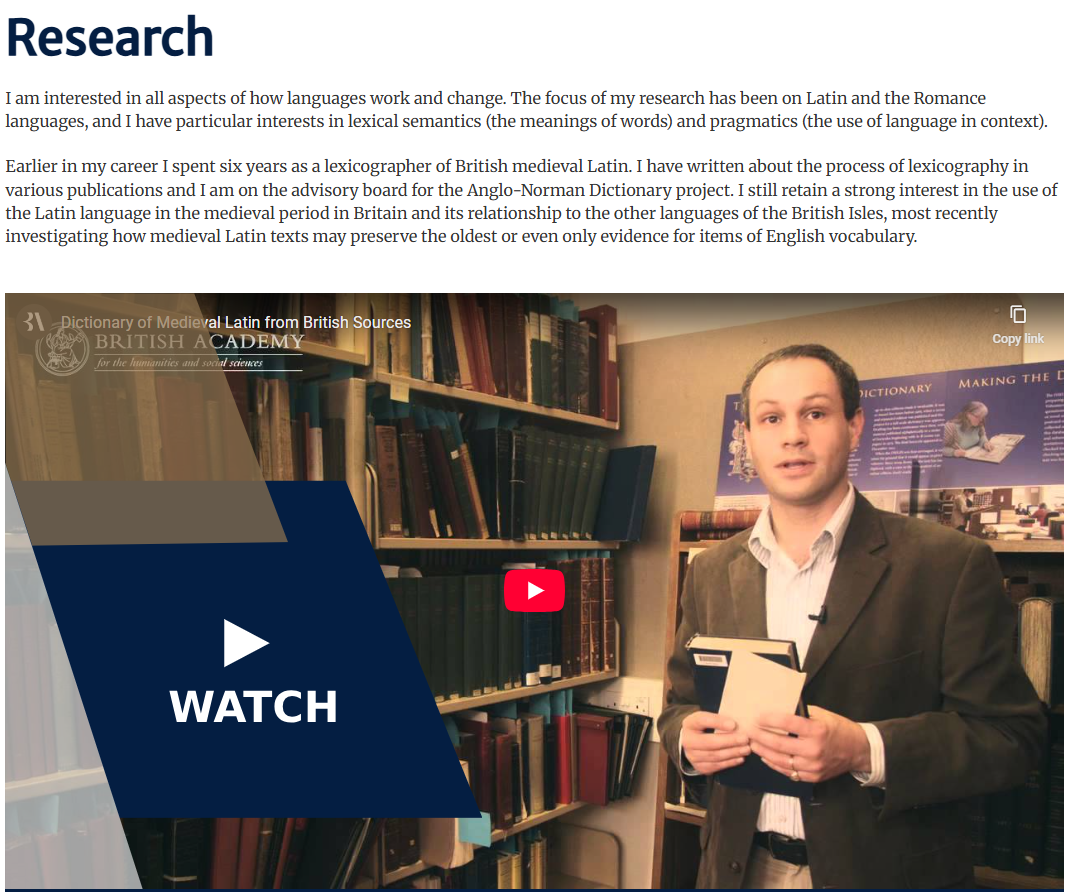
Richard Ashdowne from the University of Oxford uses a video to talk about his research.
What these profiles show is that there is flexibility in profiles. Some academics are more comfortable writing long pieces of texts with links to their work to showcase their research, while others prefer alternative methods to highlight their research. By offering flexibility in profiles, it allows academics to use them how they feel best.
PhD supervision was a popular heading, but where it was on a profile varied between universities
Where this section was varied between universities, some academics had this at the very top of their profile, often beside the contact card part of their profile, highlighting whether they were accepting new PhD students or not.
Cardiff University has an icon that displays if an academic is accepting PhD students.
If it did not display at the top of the profile like this, most other academic profiles had its own PhD supervision heading that outlined whether they were accepting PhD students, and the topics they were willing to supervise.
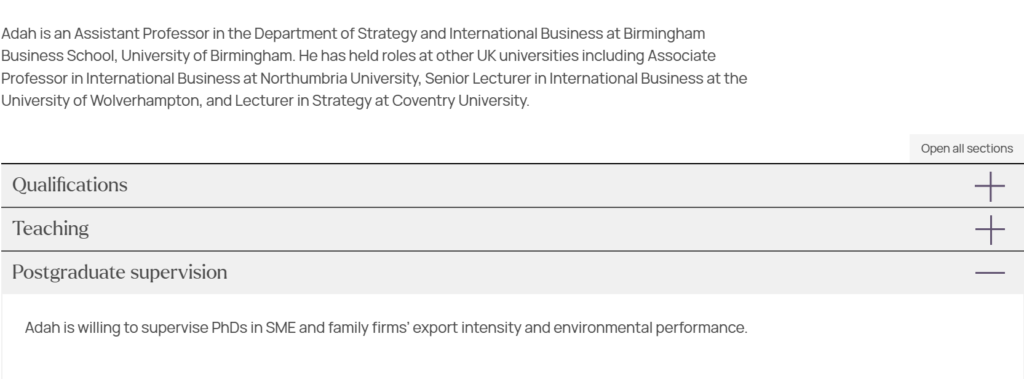
The University of Birmingham has its own heading for postgraduate supervision.
Other times, PhD supervision was a sub-heading to the research heading. This allowed academics to list topics they were interested in supervising and list out students they are supervising, and ones they have supervised in the past.
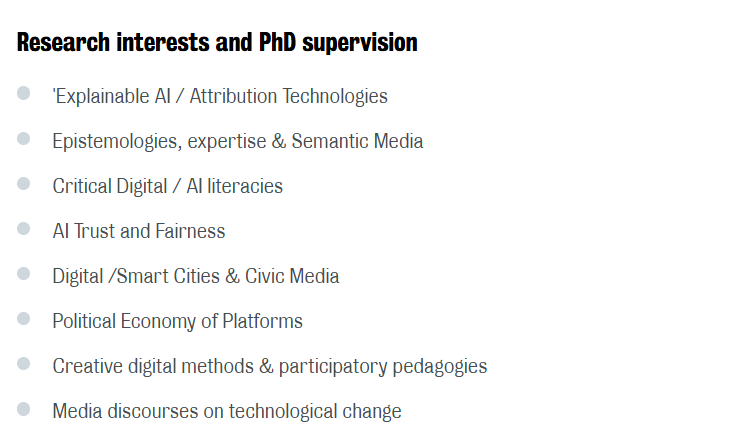
Dr Giota Alevizou of King’s College London combined research interests and PhD supervision on her profile.
Not all publications were always listed
While publications may be a self-explanatory heading, it was interesting to note how different academics utilised this section. Some included every single publication that they had been involved in or written, which in some cases led to extremely long pages.
Other academics, only listed there most recent five publications, and relied on other profiles such as PURE/Research Explorer to be the main source of all their publications.
Other headings
While the headings I’ve outlined where the most popular and most used, academics utilised other headings to boost their profile. The most notable extra headings used were:
- Teaching – listed undergraduate and postgraduate modules taught by them and often linked out to the page on each module.
- Media/Public engagement – a list of interviews conducted with the media.
- Conferences – a list of conferences that they’ve attended or helped organised.
- Professional activities and memberships – a list of organisations they are part of outside of the University that they represent.
- Related news – served as a miscellaneous category. Linked out to pages that featured their work or stories on their work.
This list does not contain all the options we came across in our research, but it was interesting to see what academics wanted to include on their profile.
Professional services staff profiles tended to be much more limited compared to academic staff
Unsurprisingly, professional services staff members tended to have much more basic profiles, compared to academic staff. Professional service staff profiles rarely contained much information other than their contact details and room location.
If they did have extra information on their profile, it was normally:
- an outline of their job description
- how long they’ve been in their role
- links to web pages association with their role, such as newsletters of their team’s web page
- link to their line manager’s profile.
Insights from this analysis helped prepare us for interviews with staff
From reviewing multiple profiles, people like to use them differently. Some will want an extensive profile and will include a lot in it. Others may only include information they feel is relevant for the target audience. This research helped us paint a picture of what people like to include on their profile and to prepare a topic guide for when we talked to staff within the University. In these interviews, we asked:
- what do you want to include on your profile?
- what is the priority content on your profile?
- what do they think the purpose of your profile is?
These are just some of the questions we asked staff. We will be sharing what we found from these interviews in upcoming blog posts.
You can read more about our research into staff profiles:
Current usage of University staff profiles: Initial insights from The Role of Profiles project
Staff perspectives on online profiles: findings from our University-wide survey
An AI tool for generating academic staff profiles using a pre-trained LLM – findings from a study
*All screenshots of profiles in this blog post are accurate as of May 13th 2025.

